The following is a visual guide to blackball pool rules as sanctioned by the World Pool-Billiards Association (WPA) and administered by Blackball International.
This content was first compiled with the help of a senior WPA official* upon the introduction of blackball in 2005.
It has subsequently been updated to show minor rule changes.
From the opening break to the completion of a frame, here’s an explanation of general play, legal and illegal shots, play resulting in fouls or loss of frame, combination shots and more.
1. Setting Up Balls And Breaking Off
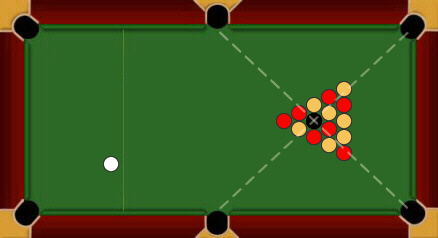
Rack the balls with the black ball positioned at the intersection of the two imaginary diagonal lines positioned as shown in the diagram.
The lag winner decides who breaks. Opposing players break alternately in successive frames.
Place the cue ball anywhere within baulk before breaking.
2. Legal And Illegal Breaks

To achieve a legal break at least two object balls (red, yellow or black) must cross an imaginary line joining the middle pockets. Alternatively, at least one ball must be potted.
If no balls are potted and two object balls do not pass over this line, then this is a standard foul and the oncoming player is awarded ‘one free shot and one visit’.
The cue ball may then be played from where it lies or from baulk. Alternatively, the oncoming player may request a re-rack.
It is also a foul if the cue ball is potted on the break. The retrieved white must be played from baulk. If the black is potted the table is set up again and the same player breaks.
On a break shot, no matter the outcome, the table remains ‘open’. Groups are never decided on the break.
There is no nomination of groups with blackball pool rules.
3. Open Table And Determining Groups
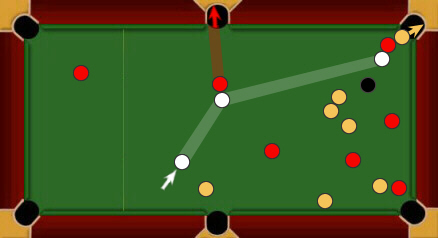
With an ‘open table’ the designated group (that is whether a player continues on red or yellow balls) is NOT determined in the following situations…
- On the break shot.
- When a foul is played on a shot.
- When taking a free shot after a foul.
- Where a combination shot is played in which balls from both groups are potted.
With the exception of those aforementioned situations, if a player pots a ball or balls from a single group the player is described as being ‘on’ that group for the duration of the frame.
So above, with an open table, potting only the red ball in the middle pocket would determine reds as that player’s group; but pot both red and yellow in a combination shot and the table remains open.
4. Play Either Group On Open Table

If an open table (that is groups have not been decided) players may play the cue ball to strike a ball from either group (reds or yellows).
In the above scenario, with an open table, a yellow ball has been played directly onto a red which in turn drops into the pocket.
That player’s group then becomes reds.
A number of exceptions are described at ‘3’ above in which an open table situation could continue.
Also note above, if the red had fallen short of the pocket and no balls struck a cushion the shot would not be ‘legal’ and a standard foul would be called (see further examples of legal and illegal shots, below.)
Remember that the black cannot be used as a ball to pot another object ball unless a foul has been committed and an initial ‘free shot’ has been awarded to the oncoming player.
5. Legal Shot Defined
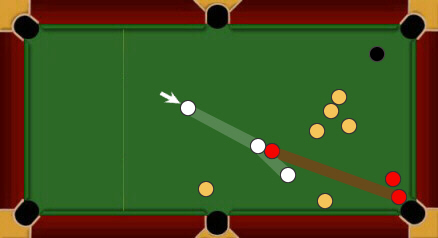
To play a legal shot a player must cause the cue balls initial contact to be with an ‘on’ ball and THEN….
(a) Pot any ‘on’ ball or balls, OR…
(b) Cause the cue ball or any other ball to contact a cushion.
An ‘on’ ball might include balls from either group or the black if a player has a ‘free shot’.
In the situation above, if the red ball falls short of the pocket and no ball strikes a cushion after the cue ball hits the red, then the referee calls a foul.
There is one exception to this definition…. escaping from a snooker, which is described below.
6. Snooker Defined
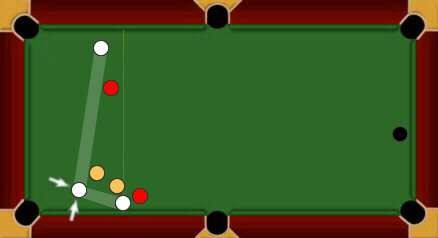
A player is ‘snookered’ when it is deemed impossible to strike any part of an ‘on’ ball by way of a straight line shot. That is the case in the the above diagram.
Players should seek confirmation that it is a “total snooker” from an opposing player, referee or other official before attempting to play out of a snooker.
7. Legal Shots And Laying Snookers

A direct consequence of the need for a ball to strike a cushion after contact with an ‘on’ ball is that it is not possible to simple tap up behind a ball to lay a snooker.
Here, in the upper shot, to lay a snooker on the black ball, either the cue ball or the red must touch a cushion after the red after has first been been struck by the cue ball.
Similarly, in the second scenario, the white gently glances against a red ball before it hits the cushion. This results in a snooker behind two reds. In this case, because it initially touched a red ball, the cue ball need not necessarily reach the two reds before it comes to rest behind them off the cushion.
8. Legal Shots And Escaping Snookers
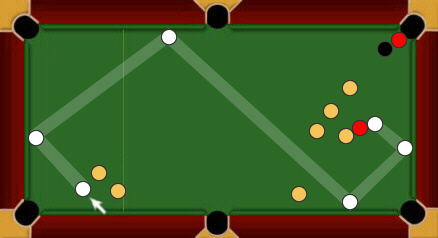
There’s an exception to the requirements of a legal shot as defined previously at ‘5’ above.
When successfully escaping a snooker, as in the diagram immediately above, it is not necessary for a ball to touch a cushion after the object ball has been struck.
It is sufficient for the cue ball to simply make contact with an ‘on’ ball.
It follows that in escaping a full snooker by way of a ‘swerve’ on the cue ball, it is not necessary for any balls to strike a cushion during the successful execution of such a shot.
9. Balls Leaving The Table
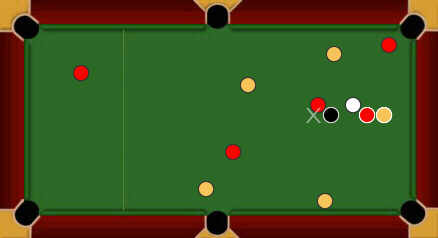
At any stage in the game, balls which leave the table are returned to the playing surface.
If the cue ball, then it’s played from baulk.
Balls are always ‘re-spotted’ on, or as close as possible to, the black spot in a direct line between the spot and the end cushion which is closest to that spot.
Above, three object balls (red, yellow and black) had left the table on the break.
In this case, with an ‘open table’, object balls are replaced in order of black, red and yellow.
Return balls to the playing surface in a straight line, as close as possible, without touching.
When not an open table (ie groups have been determined) a black ball is again always returned first but is immediately followed by any ball or balls from the group of the player just about to play.
10. Combination Shots Explained
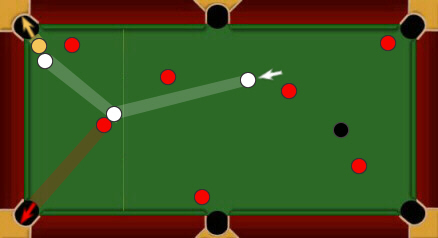
Two or more object balls can be potted without penalty in a single shot. These may be balls from both groups and could include the black ball.
In such shots the balls can drop into pockets in any order.
The object ball with which the cue ball makes initial contact must be a ball which can be legally struck, that is an ‘on’ ball.
A combination shot might be used to clear an opponent’s ball which is ‘blocking’ a pocket.
In the situation depicted the player on reds plays a combination. Sinking both the red and yellow creates an opportunity for the player on red balls to clear the table.
11. Frame Winning Combination Shot

Players may sink their last remaining group ball (or balls) and the black in the same shot and so win a frame.
Initial contact, as always, must be with an ‘on’ ball.
In this instance the player on yellows pots the final yellow ball and in the same combination shot wins the frame by potting the black ball.
12. Same Pocket Combination

There will be occasions when a combination shot is played in which two balls are potted into the same pocket.
In this example the red ball is struck and directed in such a way as to pot the black and then to follow through to drop into the same bag and clinch the frame.
13. Combination On A Free Shot
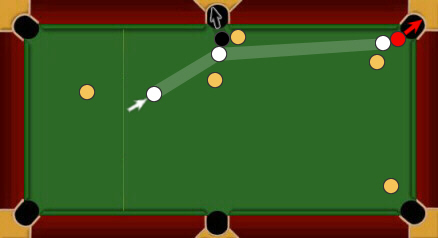
After a standard foul the oncoming player has a ‘free shot’ and may play onto any object ball on the table.
Here, the player on reds may legally strike and pot the black ball and then, in a combination shot, sink the last remaining group ball to win.
Potting the black without sinking the red, that is with one or more of a player’s group balls remaining on the table, would of course result in loss of frame.
14. Play Away From Touching Ball
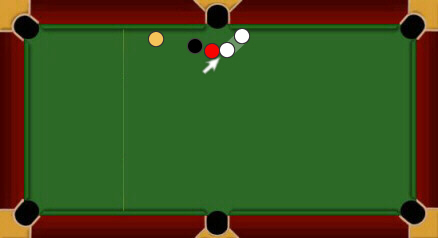
It is necessary to play away from any object ball declared to be touching the cue ball.
If, in doing so, the touched object ball moves then it is a foul.
If the cue ball is touching a ball from your own group (or indeed any ‘on’ ball) then that object ball is regarded as having been ‘struck’.
When playing away from a touching ball it is necessary to meet the requirements of a legal shot. That is an object ball must be potted or a ball strike a cushion.
Above the player is on reds. The cue ball is deemed to have struck the touching red. The player takes advantage of this opportunity by playing the cue ball onto the cushion and laying a snooker.
If playing away from a touching ball ‘not on’ the requirements of a legal shot must be met plus the initial contact of the cue ball, on playing the shot, must be with an ‘on’ ball.
15. Another Touching Ball Situation
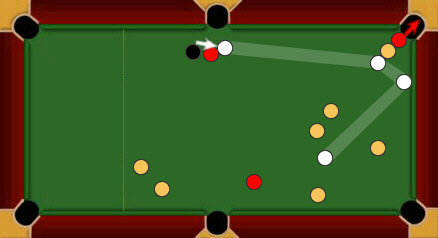
In this scenario the cue ball is touching a red ball. The player is ‘on’ reds and is considered to have struck the touching ball when playing the shot.
By striking the yellow it’s possible to sink the red over the pocket. The player then has an excellent opportunity of winning the frame.
16. Free Shot After A Foul

Following a foul the table is declared ‘open’ and the oncoming player takes a ‘free’ shot.
In doing so it is permissible to play onto any object ball. Any ball may be potted, including the black if it is ‘on’.
In each of the three situations above, the player taking the free shot is ‘on’ reds.
To the top left, a shot is legally played on to a yellow to sink a red ball.
Bottom right, an opponent’s yellow ball is played to clear the way to pot the black later in the frame.
Finally, bottom left, the player uses a free shot to bring two red balls into play.
17. Loss Of Frame Shots
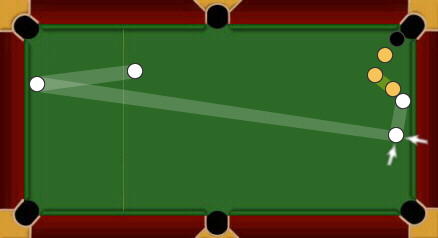
A player who clearly fails to attempt to play an ‘on’ ball OR deliberately plays a ball which is ‘not on’ will lose the frame.
The player’s group is red in this image.
Only the black remains to be potted but the player is snookered. There is a possible shot, up and down the table, to escape the snooker.
If in playing up and down the player is considered to have made little attempt to make the shot (for example by leaving the cue ball well short) there is a risk of losing the frame for playing a deliberate foul. The decision is with the referee.
The alternative call would be a ‘standard foul’ giving a free shot.
The player could (unwisely) decide to strike the nearest yellow and in doing so might open up access to the black. This is undoubtedly a deliberate foul and results in loss of frame.
18. Foul But Not Loss Of Frame
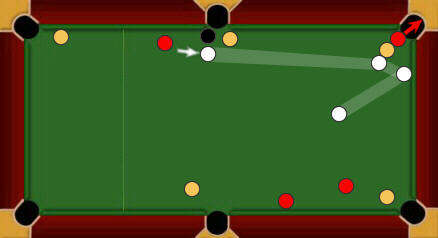
Here the player ‘on’ yellows intentionally plays a yellow ball onto a red which is potted.
The player was NOT on a ‘free’ shot.
In striking a ball from his own group first the player has fulfilled the requirements of a legal shot described above.
It is however a standard foul for potting an opponent’s ball, but it is not loss of frame.
This may be regarded as a tactical option.
The player on yellows pots a red in the expectation that, despite the award of a free shot to the opposing player, that player will not finish the frame. The hope is the red balls are so badly positioned the player on yellows is the most likely frame winner.
19. Stalemate Defined
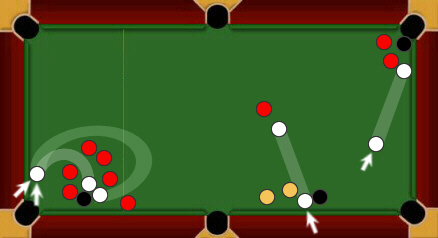
Where no legal shot is playable, whether this be by accident or design, the frame will be re-started.
Top right, the black and two reds remain on the table.
The player is ‘on’ the black.
The cue ball cannot pass beyond the reds to strike the black. This is a ‘stalemate’ and there is a re-rack.
Moving clockwise, the cue ball is touching the black and must be played away from that ball.
The player is on reds. However, regardless of the direction in which the cue ball can be played, what matters is the space between black and yellow.
If the cue ball is able to pass through that gap then it is theoretically possible to play a legal shot and the player must attempt to do so.
In the final example a legal shot can be attempted, although it’s unlikely to be successful.
There are two pathways to the black ball between the reds, so it’s NOT a stalemate.
* The above guide and accompanying images were created with the assistance of the late Peter Hawley and first published online in 2005.
Peter was Vice-President and Treasurer of the World Pool-Billiard Association and pioneered the introduction of blackball pool.
A great ambassador and tireless worker for the sport of blackball pool, Peter was also President of the All Africa Pool Association.